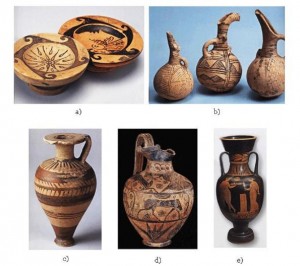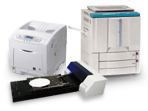
Рhotoceramics development
KIREYEVA A.G.
«The Center of Photoceramic Technologies », www.photoceramics-center.com
PHOTOCERAMICS DEVELOPMENT
The path to modern methods of drawing images on ceramics began in ancient times and started with hand painting.
The first works of images on ceramics were made many centuries ago. The first mention of such images is made in Babylonian texts, and painted objects from this time have been unearthed by modern archeologists. In ancient China there was a flourishing craft of creating images (ornamentation, images, people) on wares.
A number of works of images on ceramics, executed by masters during Ancient times:

Picture 1
a) Etruscan plates on a high leg. The end 4th – early 3rd century BC, Chivita-Kastellana, Italy
b) Clay jugs, 1800—1600 BC, Cyprus
c) Perfumery vessel of pear-shaped form – 630-590 BC, Corinth
d) Lecythus with images of solar symbols – early 6th century BC, Island Rhodes
e) The Red-figure amphora, the 2nd – late 4th century BC, Italy
The technology of drawing images on pottery requires temperature processing of a product, which facilitates the adhesion of the painted image to the product.
Different types of paints can be used: overglaze paints, underglaze paints, ceramic pigments, and other types of paints.
Perfection of the skill of ceramic painting allowed the creation of realistic pictures of nature on a mural from a ceramic tile. One of such works is presented in drawing below:
Picture 2 — Ceramic mural «Madrid», architect Anibal Gonsales. 1929 year, the Spain Square. Seville, Spain
The technology of silk-screen printing has seen widespread use in the modern era, and up to now it has been used for duplicating decal images and ware. This technology has allowed manufacturers of porcelain, glass, enameled and other ware to decorate their products with patterns and pictures of varying sizes and colors.

Picture 3- Porcelain service and set of the enameled ware
A century ago, black-and-white images on ceremonial photoceramics were made with analog decal technology using photographic techniques. This method applied adhesive to different areas of the glass, providing a way for the overglaze paint to stick to the glass.
The 1990s saw the development of new analog decal technology using black-and-white printers. This greatly simplified the manufacturing process.
A new method of black-and-white decal image production arose with the development of digital technologies in the late 1990s – this time digital. At the heart of this method lies the printing on decal paper by means of the black-and-white laser printer with special type of a toner. During the firing of the decal onto pottery, the decal turns a brownish shade caused by presence of iron oxides in the toner. This method allowed increased productivity in ceremonial photoceramics manufacturing.
Almost in parallel with this technology the Chinese experts had been developing technology of creating images on pottery by means of the jet printer and a special adhesive (sticky) ink. This was a digital technological breakthrough, allowing not only the printing black-and-white images, but also color images on ceramics and ceramic-metal. In the post-Soviet era development of this technology was pursued by both Russian (Grechko A.I., etc.) and the Ukrainian experts (Mustafin K.A., Zavalnjuk V. I., etc.). The jet printer with the coordinate table, developed by firm «PET Plast», picture 4, became one of the most successful engineering achievements in this field, allowing full-color photoceramic printing with high quality because of high-precision alignment of paint layers. Now this equipment is known under the name of Mirtels.
Picture 4 — Ceramic jet printer with a coordinate table
Jet printer with a coordinate table differs from others technologies by its ease of use and the low cost price of image printing.
In the late 20th – early 21st century, a group of scientists jointly developed a new technology of digitally printing color decals. The basis of this technology is the use of color ceramic toners in a color laser printer to print images onto decal paper.
Experts of several countries have developed modifications to laser printers and copiers for printing digital color decals. Among these experts are the engineers of “The Center of Photoceramic Technologies”, who, as a result of long-term research and engineering, have developed several modifications to the A4 and А3 printers that allow the printing of full-color decals.
For many years experts from different countries pursued research in the attempt to develop a new kind of ceramic ink for ink jet printers that would allow the creation of photographic images on ceramics. Unfortunately, the results were unsatisfactory.
Today, the newest photoceramic technology is suited not only for mass production items, but also custom products with full-color photographic quality. All this became possible thanks to scientific and technical progress in digital technologies and to persistent work o f experts in the photoceramics industry.
Kireyeva A.G.
«The Center of Photoceramic Technologies», www.photoceramics-center.com








